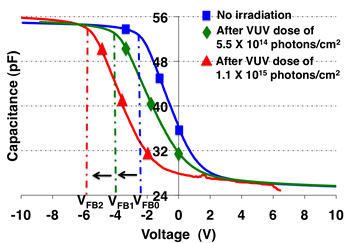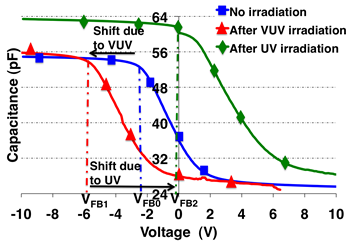Low-k Dielectrics
Capacitance-voltage (C-V) and surface-potential measurements are used to determine the effects of VUV/UV irradiation on defect states in porous organosilicate (SiCOH) dielectrics. VUV-spectroscopy is used to determine the valence-band structure and location of defect states within the bandgap of the dielectrics both before and after VUV and UV irradiation. SiCOH dielectrics have bandgap energies of about 9 eV. We find positive charge is trapped by defect states located 1 eV above the top of the valence-band edge. The measurements show that VUV photons depopulate trapped electrons from defect states within the dielectric, resulting in the generation of trapped positive charge. This is evidenced by a negative shift in the flat-band voltage of the C-V characteristic. Also, a positive surface potential, measured with a Kelvin probe after VUV irradiation, validates the presence of trapped positive charges. UV irradiation reverses the effects of VUV by repopulating the defect states with electrons photoinjected from the silicon substrate. This is evidenced by a positive shift in the flat-band voltage of the C-V characteristic and reduced surface potential. The energy peak of the defect states observed in VUV spectroscopy also correlates with the conclusions from C-V and surface-potential measurements. Thus, by suitably optimizing and/or supplementing the spectrum of the emitted radiation, it may be possible to reduce the amount of trapped charge and thus minimize damage to the dielectric.
Effect of 8eV VUV irradiation |
Effect of VUV & UV irradiation |
Poster: Effect of VUV & UV irradiation



